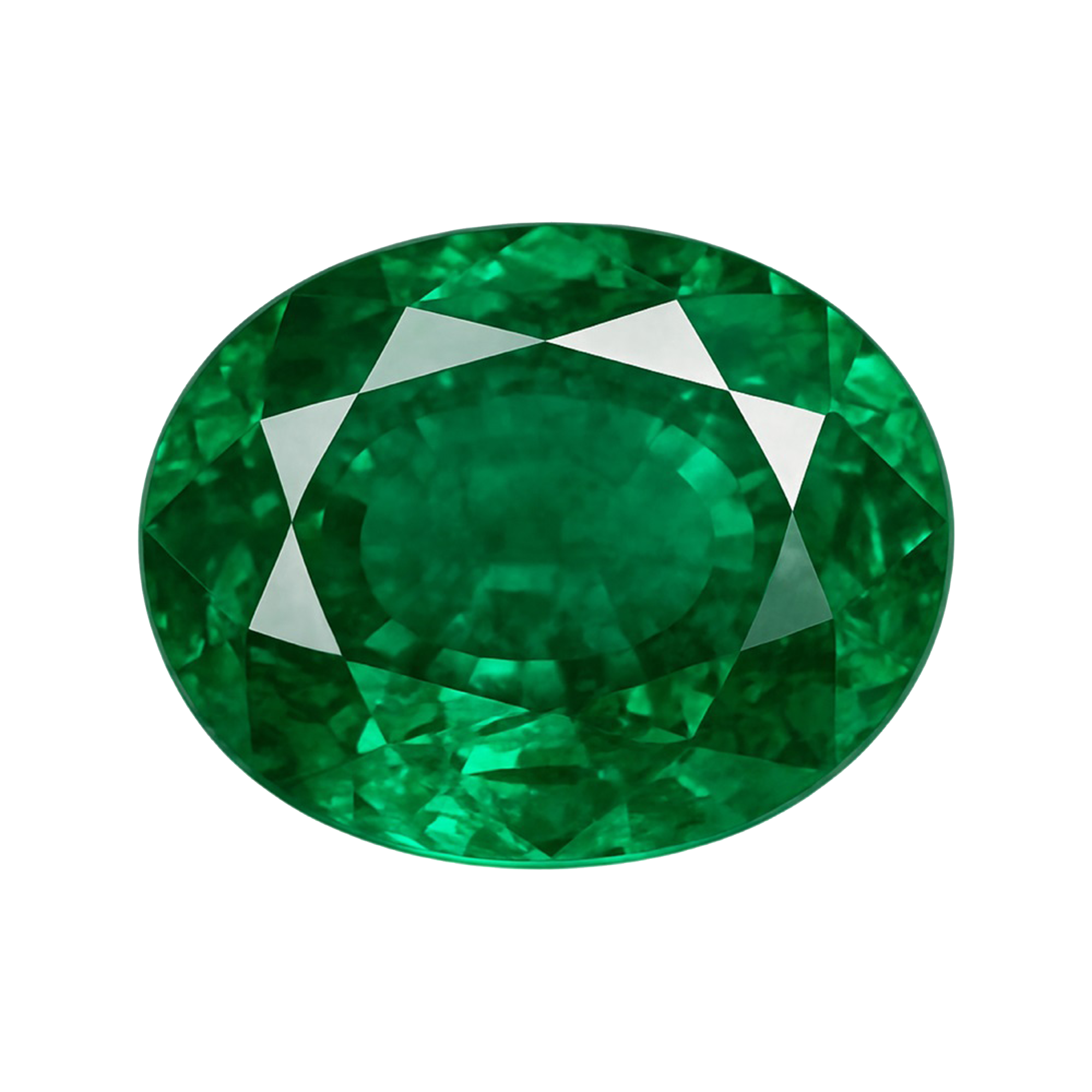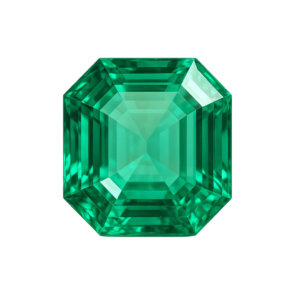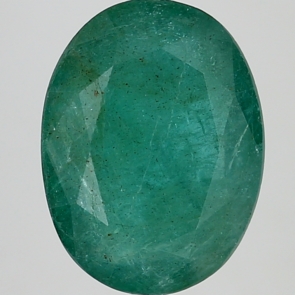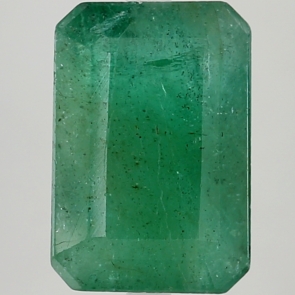
Emerald is a precious gemstone known for its vibrant green color. In astrology, it is associated with the planet Mercury & is believed to enhance communication, intelligence, and mental clarity. Wear an Emerald to attract prosperity, improve relationships, and boost confidence. It is also said to promote harmony and balance in life, making it a popular choice for those seeking to enhance their intellectual and emotional well-being.
- Activate Heart Chakra
- Enhanced Intuition and Psychic Abilities
- Prosperity and Abundance
- Wisdom and Clarity
- Creativity and Imagination
In Vedic astrology, wearing Emerald (also known as Panna) is often recommended for individuals with Gemini (Mithuna) and Virgo (Kanya) as their Sun sign or Moon sign, or if Mercury (Budha) is a prominent planet in their birth chart. Emerald is associated with the planet Mercury, and it is believed to enhance the positive attributes associated with Mercury, such as intellect, communication skills, and financial prosperity. However, it is essential to consult with a knowledgeable astrologer who can analyze your birth chart comprehensively to determine if wearing an Emerald is suitable for you and to recommend the correct weight, metal, and wearing procedures based on your astrological configuration.
In Vedic astrology, wearing an Emerald stone (Panna) is considered beneficial when certain guidelines are followed. Here is how to wear an Emerald stone based on Vedic astrology:
1. Consult an Astrologer: Before wearing an Emerald, it’s crucial to consult with a qualified Vedic astrologer who can analyze your birth chart (horoscope) to determine if wearing the stone is suitable for you. The astrologer will consider factors such as your ascendant (lagna), the position of Mercury (Budha) in your chart, and any potential doshas (afflictions) before recommending the stone.
2. Choosing the Emerald: Ensure that the Emerald you choose is of good quality, as per astrological standards. The stone should be natural, untreated, and preferably have a deep green color. It’s advisable to purchase the stone from a reputed and trustworthy source.
3. Wearing Day and Time: According to Vedic astrology, the best day to wear an Emerald is Wednesday, which is associated with the planet Mercury. Additionally, the ideal time for wearing the stone is during the ascending period of the Moon (Shukla Paksha). Consult your astrologer for the specific auspicious timing based on your birth chart.
4. Metal and Ring Finger: Emerald is typically worn in a ring made of gold or silver. The ring should be worn on the little finger (pinky) of the right hand for men and the left hand for women. However, the specific finger and hand can vary based on individual astrological considerations, so it’s best to follow the guidance provided by your astrologer.
5. Purification and Energization: Before wearing the Emerald ring for the first time, it should be cleansed and energized to remove any negative energy and enhance its positive effects. This can be done through various rituals, prayers, or mantras as prescribed by
your astrologer.
6. Regular Maintenance: Once you start wearing the Emerald ring, it’s essential to take care of it properly. Clean the stone regularly using a soft cloth and avoid exposing it to harsh chemicals or extreme temperatures. Additionally, periodically recharge the stone’s energy by placing it in sunlight or moonlight for a few hours. Remember that the effectiveness of wearing an Emerald stone in Vedic astrology depends not only on wearing it correctly but also on various other astrological factors in your birth chart. Therefore, it’s crucial to follow the guidance of a knowledgeable astrologer for the best results.
In Vedic astrology, the Emerald gemstone (Panna) is associated with the planet Mercury (Budha) and is believed to offer numerous benefits to the wearer. Some of the key benefits of wearing an
Emerald include:
1. Enhanced Communication Skills: Emerald is said to strengthen the influence of Mercury, which governs communication, speech, and intellect. Wearing an Emerald is believed to improve one’s ability to articulate thoughts clearly, express ideas effectively, and communicate with confidence.
2. Improved Intellect and Learning: Mercury is associated with intelligence, logic, and learning. Wearing an Emerald is thought to enhance mental clarity, concentration, and analytical abilities, thereby aiding in academic pursuits, studying, and problem-solving.
3. Financial Prosperity: Emerald is believed to attract wealth and prosperity, as Mercury also governs commerce, business, and financial transactions. Wearing an Emerald may enhance opportunities for financial growth, success in business ventures, and the
accumulation of wealth.
4. Promotion of Creativity: Mercury is associated with creativity and artistic talents. Wearing an Emerald is said to stimulate creativity, inspire innovative thinking, and enhance artistic expression in various fields such as writing, music, and the arts.
5. Enhanced Intuition: Emerald is thought to have a calming and balancing effect on the mind, promoting mental clarity and intuitive insights. Wearing an Emerald may help in making sound decisions, trusting one’s instincts, and navigating through complex situations with ease.
6. Harmonious Relationships: Mercury influences interpersonal relationships and communication dynamics. Wearing an Emerald is believed to foster harmonious relationships, improve understanding between partners, and promote effective communication in personal and professional interactions.
7. Healing Properties: In addition to its astrological benefits, Emerald is also believed to have healing properties, particularly related to the eyes, nervous system, and respiratory system. It is thought to alleviate stress, soothe emotional disturbances, and promote
overall well-being.
It’s important to note that the effectiveness of wearing an Emerald stone may vary for each individual, depending on their astrological chart and specific circumstances. Therefore, it’s advisable to consult with a knowledgeable astrologer before wearing an Emerald to ensure it is suitable for you and to receive personalized guidance on how to derive the maximum benefits from the gemstone.
The quality of an Emerald is typically assessed based on several key factors, including color, clarity, cut, and carat weight. Here’s a breakdown of each quality factor:
1. Color:
Hue: The most desirable hue for Emeralds is a pure, vibrant green without any secondary colors such as yellow or blue. The color should be evenly distributed throughout the stone.
Saturation: Emeralds with intense saturation of color are more valuable. Stones with a deep, rich green color are highly prized.
Tone: The tone of an Emerald refers to its lightness or darkness. Ideally, Emeralds should have a medium to medium-dark tone, neither too light nor too dark.
2. Clarity:
Inclusions: Emeralds commonly have natural inclusions, which are often referred to as “jardin” (French for garden) due to their resemblance to foliage. However, fewer inclusions and greater transparency are desirable. Eye-clean Emeralds (those with no visible inclusions to the naked eye) are particularly valuable.
Transparency: Emeralds should have good transparency, allowing light to pass through the stone without significant obstruction.
3. Cut:
Shape: Emeralds are typically cut in various shapes, including Emerald-cut (rectangular with truncated corners), oval, round, and pear shapes, among others. The cut should showcase the stone’s color and minimize the appearance of inclusions.
Proportions: Well-proportioned cuts maximize the stone’s brilliance and color. The facets should be aligned correctly to enhance the Emerald’s natural beauty.
4. Carat Weight:
The size of an Emerald is measured in carats, with larger stones generally being rarer and more valuable. However, quality considerations such as color, clarity, and cut also significantly impact the value, so carat weight alone is not the sole determinant of quality.
5. Origin:
The origin of an Emerald can influence its quality and value. Stones from renowned sources such as Colombia, Zambia, and Brazil are often associated with superior quality and command premium prices due to their reputation for producing exceptional Emeralds.
The price of Emeralds can vary significantly based on several factors, including:
1. Color: The most critical factor influencing the price of an Emerald is its color. Emeralds with a vibrant, pure green color without any hints of brown or gray are the most valuable. The intensity and saturation of the green hue also play a significant role in determining the price.
2. Clarity: Clarity refers to the presence of internal inclusions and external blemishes within the Emerald. Emeralds with fewer inclusions and excellent transparency command higher prices.
3. Cut: The cut of an Emerald can affect its beauty and value. Well-cut Emeralds that maximize the stone’s brilliance and color are more desirable.
4. Carat Weight: Like other gemstones, the price of Emeralds increases with higher carat weights, all other factors being equal.
5. Origin: Emeralds from certain locations, such as Colombia, are often associated with superior quality and command premium prices due to their reputation and rarity.
Due to the variability in these factors, prices for Emeralds can range from a few hundred dollars per carat for lower-quality stones to tens of thousands of dollars per carat or more for top-quality Emeralds with exceptional color, clarity, and origin.
It’s important to purchase Emeralds from reputable sources and have them evaluated by a certified gemologist to ensure authenticity and quality.
When evaluating the quality of an Emerald, it’s essential to consider all these factors collectively. A high-quality Emerald will exhibit a vivid green color with excellent clarity, a well-proportioned cut that enhances its brilliance and a significant carat weight if size is a consideration. Additionally, Emeralds from reputable sources with a known history of producing fine gemstones are generally more desirable.
Here are common types of Emerald gemstone jewelry:
- Emerald Rings: Classic and elegant, Emerald rings are popular as engagement or statement rings, often set in gold or platinum with accent diamonds or other gemstones.
- Emerald Earrings: Available in stud, hoop, or drop styles, Emerald earrings add a vibrant touch to any outfit.
- Emerald Pendants and Necklaces: Centering an Emerald as a pendant creates a striking focal point, often accompanied by complementary gemstones or intricate metalwork.
- Emerald Bracelets: From delicate tennis bracelets to bold cuff designs, Emerald bracelets offer a luxurious wrist adornment.
- Emerald Brooches and Pins: Vintage or modern, Emerald brooches provide a sophisticated way to accessorize clothing or scarves.
- Emerald Jewelry Sets: Coordinated sets, including rings, earrings, and necklaces, provide a cohesive and elegant look.
- Emerald Beaded Jewelry: Stringing Emerald beads creates necklaces, bracelets, or earrings with a more casual or bohemian style.
Each type of Emerald jewelry can highlight the gemstone’s vibrant green hue and unique inclusions, making it a versatile choice for various occasions.
Here are some cleaning and care tips for Emerald gemstones:
Cleaning and Care Tips for Emeralds
- Gentle Cleaning: Use warm, soapy water and a soft brush or cloth to clean your Emerald. Avoid harsh chemicals or ultrasonic cleaners, as they can damage the stone or its treatments.
- Avoid Harsh Chemicals: Keep Emeralds away from acids, bleach, and household cleaners that can damage the surface or treatments.
- Handle with Care: Emeralds are relatively soft and can scratch or chip easily. Store separately in a soft cloth or jewelry pouch to prevent contact with other jewelry.
- Avoid Extreme Temperatures: Sudden temperature changes can cause fractures. Keep Emerald jewelry away from heat sources and avoid wearing in hot showers or saunas.
- Limit Exposure to Sunlight: Prolonged exposure to sunlight can potentially fade or alter the appearance of the gemstone.
- Regular Inspection: Check the setting periodically for stability and any damage. Have a professional jeweler inspect and clean your Emerald jewelry once a year.
- Re-oiling: Emeralds are often oiled to enhance clarity. Over time, this oil can wear off. Have your Emerald professionally re-oiled as needed, usually during routine cleaning.
By following these tips, you can preserve your Emerald’s beauty and longevity.
Here’s a “Buyer Beware” message for emerald gemstones:
- Authenticity: Not all Emeralds are natural; some may be treated or synthetic. Always request certification from a reputable gemologist.
- Treatments: Many Emeralds are treated with oils or resins to enhance color and clarity. These treatments can affect value and durability. Transparency about treatments is essential.
- Color and Clarity: Deep, vibrant green with good transparency is ideal. Be cautious of overly included stones, as inclusions are common in Emeralds and can impact durability.
- Pricing: Emeralds can vary widely in price based on quality, size, and treatment. Be wary of deals that seem too good to be true.
- Cut and Size: Proper cut enhances the gemstone’s beauty. Examine the cut and setting to ensure quality.
- Source and Certification: Purchase from reputable sources with proper certification to verify origin and quality.
- Durability: Emeralds are relatively soft (7.5-8 on Mohs scale) and prone to scratching and cracking. Handle with care and avoid harsh chemicals.
Always conduct thorough research and seek expert advice before purchasing an Emerald gemstone.
Featured Products

 Cart is empty
Cart is empty 

